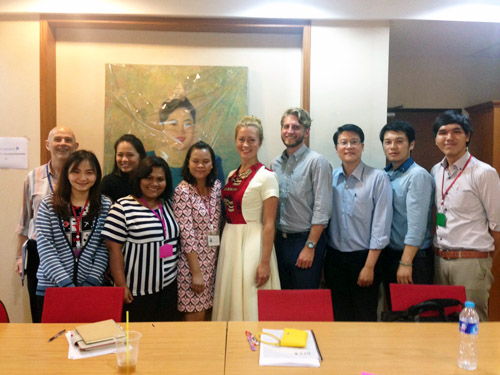
Dr. Rachel Vreeman (5th from right) with the adherence study team at HIV-NAT/Thai Red Cross AIDS Research Centre in Bangkok.
Access to antiretroviral therapy (ART) is increasing among the 3.4 million children living with HIV globally—though in many regions their rates of treatment access remain lower than adults. Because HIV-positive children face a lifetime of ART, adherence is critical to ensuring that they do not develop resistance, especially in countries where access to second- and third-line therapies remains limited.
However, children and adolescents can face many challenges adhering to their medications, and little data currently exists in resource-limited settings on rates of adherence, how best to support and monitor how and when they take their antiretrovirals, and risk factors for non-adherence. To help gather these data, the U.S. National Institutes of Health’s International Epidemiologic Databases to Evaluate AIDS (IeDEA) global consortium has launched a new study aiming to develop and validate a standardized tool to measure and better understand adherence among young people. The study will build on research already done by an IeDEA site in Kenya. TREAT Asia, which has led the Asia-Pacific component of IeDEA since 2006, will work with HIV-NAT at the Thai Red Cross AIDS Research Centre to conduct a Thai component.
“We have examined the issue of adherence in our large cohort of children in Kenya, and now we are working on a global evaluation of children’s adherence,” says Dr. Rachel Vreeman, director of research for the Indiana University Center for Global Health and the AMPATH Research Program in Kenya. “We are building on our global collaboration among HIV care systems in the IeDEA Consortium to determine what works for children in care systems worldwide."
The study will employ and evaluate a brief standard questionnaire that can accurately assess young people’s adherence. It was developed by the Kenyan team after testing 48 proposed questions to determine which 10 prompted children to most accurately and honestly report their issues with adherence. The study will also examine current adherence among children at the three participating IeDEA sites in Kenya, South Africa, and Thailand, evaluate factors that increase the risk of non-adherence, and assess the impact of non-adherence on treatment failure and clinic drop-out.
Each site will aim to enroll approximately 100 children aged 14 and under and their caregivers, for a total of up to 300 participating families. As part of the study, each child will be given special pill bottles with Medication Monitoring Systems (MEMS)—electronic bottle caps that mark the time and date each time the bottle is opened—to help determine how the children’s answers to the adherence questions match their use of the MEMS bottles. The researchers will also measure adherence through pill counts and monitoring viral loads.
“This is a great opportunity for our partners at HIV-NAT to work with our IeDEA colleagues in Africa and the U.S. on an essential component of treatment success,” says Dr. Annette Sohn, amfAR vice president and director of TREAT Asia. “We need to find better ways to make it easier for young people to take their medicines.”